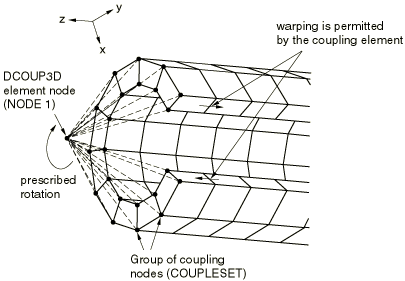Distributing coupling elements | |||||||
|
| ||||||
ProductsAbaqus/Standard
Typical Applications
The distributing coupling element constrains the motion of the coupling nodes to the translation and rotation of the element node. This constraint is enforced in an average sense and in a way that enables control of the transmission of loads. These characteristics make the distributing coupling element useful in a number of applications:
The element can be used to prescribe a displacement and rotation condition on a boundary in cases where relative motion among the nodes on the boundary is required. An example of such a case is prescribing a twist on the end of a structure that is expected to warp and/or deform within the end surface (see Figure 1).
Figure 1. DCOUP3D element used to impart a rotation on the surface of a structure without constraining motion within the surface.
The element can be used to provide, through the motion of the reference node, a weighted average of the motion of the coupling nodes.
The element can be used to distribute loads, where the load distribution can be described with moment-of-inertia expressions. Examples of such cases include the classic bolt-pattern and weld-pattern load distribution expressions.
The element can be used as a coupling between two parts (structural-solid) to transfer forces and moments. In comparison to MPCs and the kinematic coupling constraint, the distributing coupling element can be considered a more “flexible” connection.
![]()
Choosing an appropriate element
Two- and three-dimensional distributing coupling elements are available. Element DCOUP2D describes behavior only in the global X–Y plane. Element DCOUP2D can be used in an axisymmetric analysis; however, its use requires care in selecting the load distributing weight factors. For example, a uniform axial load distribution to a structure would require specification of load distribution weight factors in proportion to the radius of the coupling nodes. Since the radius of these nodes will change with deformation, this use of DCOUP2D would only approximate the correct load distribution behavior in a large-displacement analysis.
![]()
Defining the distributing coupling
To define a distributing coupling, you specify the coupling nodes to which loads are to be distributed, along with the corresponding weighting of the distribution. A minimum of two coupling nodes is required.
Input File Usage
DISTRIBUTING COUPLING, ELSET=name node number or node set, weight_factor_1 node number or node set, weight_factor_2 ...
Example
This example (see Figure 1) illustrates the use of the DCOUP3D element to impart a rotation to the surface of a structure that is expected to deform in a general way. In this case warping and motion within the plane of the end surface are expected to occur.
ELEMENT, TYPE=DCOUP3D, ELSET=ROTATEELEMENT 1001, 1 DISTRIBUTING COUPLING, ELSET=ROTATEELEMENT COUPLESET, 1.0 … STEP, NLGEOM … BOUNDARY 1, 6, 6, 1.0 … END STEP
![]()
Defining the load distribution
The element distributes loads such that the resultants of the forces on the coupling nodes are equal to the forces and moments on the element node. For cases of more than a few coupling nodes, the distribution of the forces is not determined by equilibrium alone, and the user-specified weight factors are used to define the distribution. The weight factors are dimensionless and are normalized within each element so that the sum of all weight factors is one. As a consequence, the normalized weight factors describe the proportion of the total element force and moment that is transmitted through the particular coupling node. In the case of transmission of forces alone, the proportion of force transmitted through the node is simply the normalized weight factor. In the general case of transmission of forces and moments, the force distribution follows that of a classic bolt-pattern analysis, where the weight factors could be considered the areas of particular bolt cross-sections. Refer to Distributing coupling constraints for specific details of the load distribution.
In the example shown in Figure 1 the weight factor distribution chosen is homogeneous, with a value of 1.0. For the rotation depicted, a more accurate load distribution would reflect the fact that the shear forces on nodes near the edge of the slot will diminish to zero, which could be described by choosing individual weight factors for nodes near the slot edge. If the loading on the element were along the axis of the structure, the homogeneous distribution shown would be appropriate. For cases where different loading modes require different descriptions of the weight factor distribution, multiple distributing coupling elements with different element nodes and different weight factors can be used.
Colinear coupling node arrangements
The distributing coupling element transmits moments at the element node as a force distribution among the coupling nodes, even if these nodes have rotational degrees of freedom. Thus, when the coupling node arrangement is colinear, the element is not capable of transmitting all components of a moment at the element node. Specifically, the moment component that is parallel to the colinear coupling node arrangement will not be transmitted. When this case arises, a warning message is issued that identifies the axis about which the element will not transmit a moment.
Use with nonuniform meshes
When the distributing coupling element is used with coupling nodes attached to elements of varying size, care should be taken in selecting the weight factors. The weight factor selected for a node should generally scale with the size of the elements attached to that node.
![]()
Output
Element nodal forces (the force the element places on the element and coupling nodes) are available through element variable NFORC. Element kinetic energy is available in dynamic procedures through the whole element variable ELKE.